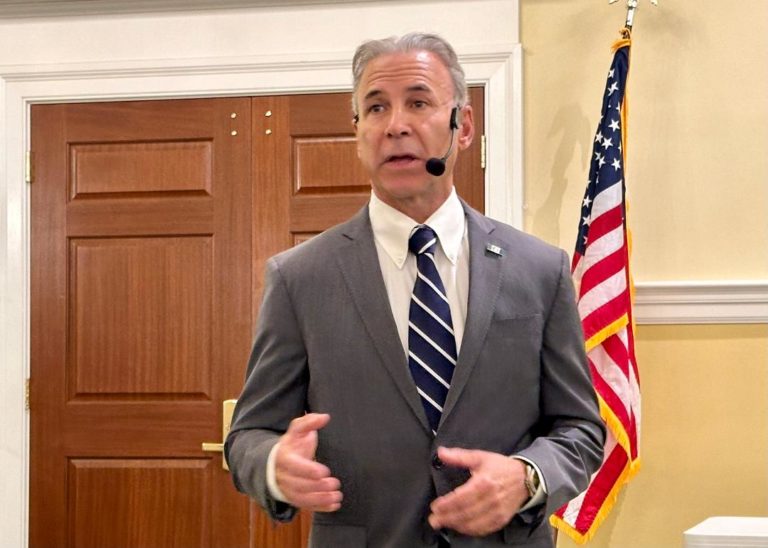

By: Bobbi Eggers
Everybody is outside walking. We all have routines now, whether it’s in your neighborhood or hiking on a dirt path, but my favorite is Greenwich Point. I cherish my walks there. It’s our dog’s favorite place on earth during the months they are allowed there. She picks up the beach smells when our car rounds the corner off Sound Beach Avenue. Her eyes are bright, she hops into the front seat, and can’t wait to get out of the car. During this pandemic, I ask my friends to walk all the time. It lifts my spirits and is one of the joys in my pandemic life. “Ladies who lunch” became “women who walk.” I force myself away from my desk by booking walks with friends or family. I have reconnected with people I been missing for years, and I am so happy about it. The wind can be howling, but we walk and talk about life and all the craziness before, during and ahead of us. Fresh air and love. Nothing better.
In my “walk talks” I have discovered that many of my friends had never frequented Greenwich Point pre-pandemic. To me, it’s like living in NYC and not being aware of Central Park. I find I enjoy things so much more when I know a little bit about what I am looking at. Like a painting in a museum or travelling to another city, it enriches my experience. So when you walk “the loop” with your partner or friends, it’s not just trees and beaches and a couple of concession stands. Greenwich Point has fascinating stories and, I am sure, a few ghosts.
I did some homework online, so I give all of the credit to the Greenwich Point Conservancy and Greenwich Historical Society, who both have much more detail and timelines online.
Originally called Monakewego (“Shining Sands”) it was owned by the Sinawoy Native Americans. In 1640, it was purchased for 25 coats by Capt. Daniel Patrick and Elizabeth and Robert Feake. The purchase was in Elizabeth’s name. According to the Greenwich Point Conservancy, “this was among the earliest instances of a woman individually holding title to real property in the New World.” They named it Elizabeth’s Neck. Jeffrey Ferris later purchased the property and held it for over 200 years.
The introduction of the railroad in 1848 changed Greenwich quickly with easy access for New Yorkers. After the Civil War, the industrial boom created millionaires who began building grand summer “cottages” along the shoreline. Among the wealthy New Yorkers who bought a home in the community of “Sound Beach,” (later renamed Old Greenwich), was a Scottish emigrant, John Kennedy Tod, who made his fortune constructing railroads. In 1887, they began purchasing parcels of land, combining them and renaming it Innis Arden (which later moved to where the club is now.) It was a waterfront playground for their wealthy friends, open to the local residents. Maria and John Tod never had children and were extremely philanthropic, especially to the New York Presbyterian Hospital. A fascinating couple, they sometimes hired women to do jobs that were traditionally held by men. The charming cottage just before the entrance to Greenwich Point, was built to house Maria Tod’s widowed sister-in-law and her daughters. The architect was a woman, Katherine Cotheal Budd. The Tods also hired a female landscape architect, Marian Cruger Coffin.
As you drive into Greenwich Point on the left, the Bruce Museum Seaside Center was originally built by Tod as a summer cottage, to house Presbyterian Hospital of New York nurses, as a vacation respite from their hard work in New York City. One of the nurses, Anna Maxwell, founded Columbia University’s School of Nursing. Greenwich Point Conservancy restored the building in 2011, when it became the home of the Floren Family Environmental Center, named in honor of Douglas and CT State Representative Livvy Floren. where the Bruce Museum’s Seaside Center now resides.
Next door is my very favorite place to have summer dinners, the Sue H. Baker Pavilion at the Old Barn, named after the beloved Marine Biology and Honors Oceanography teacher at Greenwich High School. An avid environmentalist, she taught there for 25 years. Susie is at “her” pavilion on many evenings, enjoying all her friends, and saying hello to everyone. The Ambassador of Greenwich Point, she is a member of the Greenwich Aquatics Hall of Fame, coached Olympic divers and was honored for the Spirit of Greenwich award. The Old Barn was built by Tod in 1887. It is the oldest surviving structure at Greenwich Point with magnificent stone pillars. Decimated during Hurricane Sandy, it was beautifully restored and FEMA-compliant, with a 4,000 sq. foot deck overlooking the beach. Filled with picnic tables and umbrellas, you can bring your own food, or order from the concession. It is always busy, socially distanced, and a very special place in Greenwich.
“The Loop,” as many of us refer to the walkway, is man-made. Tod joined two small islands, built the road around the pond, and made the main causeway with fill from a NYC subway project, brought up on barges. He added a tide-control gate and created the lake from a tidal marsh, which he enjoyed as a bird sanctuary. According to the Greenwich Historical Society, “Eagle Pond takes its name from the eagle sculpture that Tod installed in 1905 on the small island on the southern side of the pond. Local Stamford sculptor and New York hotelier James Knowles created a new bronze eagle for the island in 1979 through the generosity of Helen Binney Kitchel.” The sculpture’s wingspan is 14 feet wide. Ospreys build large nests there every year.
Perhaps because of his Scottish roots, Tod also built a 9-hole links golf course, which is now parking lots. According to www.greenwichpoint.org, there were 64 original members who paid $12.50 a piece at the turn of the century. Open to visitors, it became too popular and Tod closed his land use to all but his invited guests.
As you walk along the loop, you’ll see the Holly Grove, marked with a large sign. In 1959, the Kitchels, who had donated the eagle sculpture, donated twenty one species of holly to commemorate their wedding anniversary. Mrs. Kitchel was the daughter of the founder of Crayola Crayons. An avid environmentalist, she served four terms in the CT House of Representatives. Beyond the Holly Grove is a path that leads to Founders Rock (which, oddly, was not where the Greenwich Founders actually landed.) It was placed on the hilltop in memory of Mr. Tod.
The Old Greenwich Yacht Club and dock was built by Tod for his friends who would come up from Manhattan on yachts. They kept canoes and small sailboats for guests. Further along on the left, the Greenwich Community Sailing School, is in the “Chimes Building.” Originally a stable and carriage house, Tod used to keep a bear in a cage in this building. The Tower clock and 15 bells were cast by the maker of the original Big Ben in London. The Chimes Tower is being restored and is dedicated to the life and memory of Emily Catherine Fedorko, who died in a tragic boating accident just offshore. When refurbished, the Chimes Tower and the new Water Safety Center will honor her life and the chimes will be named “Emily’s Chimes.” For more information visit www.emswy.org.
It is also sad to see the Thames Shipwreck along the walk. The Greenwich Historical Society says it caught fire and sank on April 29, 1930. “The wife of Arne Larson, the estate caretaker, first saw the burning steamer from the mainland. She could do little but alert the Sound Beach Fire Department and watch in horror.”
The Tods built their main, 38 room estate, in the heart of the property, nestled in the trees, and entertained lavishly. John died in 1925, at the age of 72. His widow remained in the home until 1939, when it was passed to the NY Presbyterian Hospital, who later sold it to The Town of Greenwich in 1945 for $550,000. The Town converted the Tod’s home into 13 apartments for war veterans, but it became run down and the Town demolished it in 1961. Only the Tower and a part of the foundation remains.
It is a sacred place and has been an emotional lifesaver for so many people, especially during this pandemic. It is one of the best reasons to live here. Even during these winter months, some of my friends drive from backcountry tp walk along the Sound, or have doggy playdates on the beach. Children and families build sandcastles even though they are bundled up in winter coats; masks and hats covering all but their eyes. There are so many people there on the weekends, they have to turn some away. Will we still be walking when this awful pandemic subsides? I hope so. It clears our head, refreshes our soul, and calms our nerves- a lesson we should carry into the future. Fresh air and love. Nothing better.
Thank you to all the people who care about our history and have such thorough documentation online and in our museums. Please visit their websites for more information.
Greenwich Point Conservancy www.greenwichpoint.org
Greenwich Historical Society www.Greenwichhistory.org




